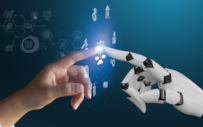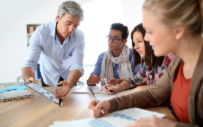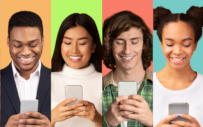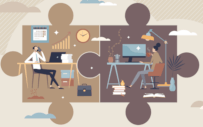
Research conducted by Mary Scott shows candidates’ increasing “lack of enthusiasm” about employer use of AI as a screening tool.

Career services offices are often seen as places that offer help with resumes and run career fairs—but their impact beyond that is lost. Data can help pain a complete picture.

Hybrid and in-person remain the preferred work modalities of employers for both their overall and entry-level positions, which matches the ways students prefer to work, NACE research has found.

In-person activities are the most widely used and effective means for recruiting interns, according to results of NACE’s 2025 Internship & Co-op survey.

The Career and Life Design process that Hassan Akmal created is evolving. Today, AI makes this pursuit more tangible than ever, acting as an unprecedented sounding board for self-exploration.

LinkedIn can be a valuable tool for students preparing to enter the workforce, but it can also cause students to miss out on opportunities if not used responsibly.

By using a gamified approach to career development, college career services can create scenarios that simulate the workplace and encourage active student participation.

Among the main reasons why career center staff are not using AI with students are concerns about the technology collecting students’ personal data.

There are two primary reasons that career centers might lack confidence in using AI in their work: speed and ethics.

Aurora University’s career services office uses ChatGPT as a tool to help its students prepare for job interviews and teach them ethical ways to use generative AI.

Fear of AI has turned into curiosity, says Jeremy Schifeling, who reports seeing more and more career leaders getting excited about leveraging these tools for both their students’ and their own success.

AI can support first-generation students in the job search by bridging the gap in their professional network.

The college winner of the 2024 NACE Technology Excellence Award, University of California, Berkeley Career Engagement used Google Workspace products to create a data-visualization dashboard to tell its story in a low-cost, efficient manner.

Career services professionals can help students use AI tools effectively and avoid common traps and mistakes.

Women remain underrepresented in computer science majors and careers. Two researchers conducted a study to see how women in computing experience and make sense of their internships, and how their internship experiences shape their future career plans.

Students who begin building their social media presence while still in college will have an advantage after graduating, and there are several easy steps they can take to get started on LinkedIn.

The University of Western Florida CDCE recently launched its AI Career Toolkit to address AI use, challenges, and possibilities by students exploring careers and the career coaches supporting them.

Despite calls to “return to the office” from employers and the prevailing media narrative, the hybrid work modality appears here to stay.

The Yale Office of Career Strategy enlisted the help of key partners to create an assessment tool that incorporates design-thinking principles and is available to everyone, not just Yale students and alums.

The career services office at Colorado Boulder launched an Artificial Intelligence Working Group to collect information on developments, discuss campus applications of AI, and more.

UCSD’s Rady School Career Management Center is addressing and creating resources around AI to guide students in its effective, safest, and ethical use during the college recruiting process.

This study, a collaboration between NACE and Break Through Tech, provides evidence that career services can help level the playing field for women pursuing STEM careers.

In 2022, Cappfinity partnered with EY’s UK student recruitment team to deliver an immersive, inclusive, and differentiated approach to early careers recruiting, creating VR for intern attraction and development.

Automated video interviews (AVIs) are an emerging recruitment tool. As success factors in AVIs may differ from face-to-face interviews, it is important for career services practitioners to know how to help their students prepare for these new types of interviews.

Not only does PathwayU offer student assessments, but it also provides guidance based on predictive knowledge that accounts for the user’s sense of purpose and meaning.

Many URR and career services functions are using artificial intelligence (AI) to streamline their processes and enhance their operations. However, there are potential legal risks adopters should consider as they move from dipping their toes into the AI pool to fully diving in.

In 2021, Hope College’s Boerigter Center for Calling and Career partnered with several computer science majors to develop a custom, interactive application for the college’s students and visitors to see a visual representation of the locations of Hope alumni around the world and their jobs. It also shows current job and internship openings in a given city.

In a unique interview with ChatGPT, NACE asks the AI language model how it feels about its use as a tool in the job search, career readiness, and talent acquisition; the ethics of its use; and more.

Members of the NACE Community recently offered some suggestions to their colleagues for books to add to their summer reading lists.

NACE has conducted research that identifies important trends and unearths key insights that can help members enhance or adjust their operations to meet challenges and demands.

Among the key information recruiters need to know to successfully navigate their careers is to stay informed and value relationships.

Employers are strongly committed to in-person college recruiting activities this fall as they are largely unencumbered by travel restrictions that organizations imposed during the COVID-19 pandemic, according to results of NACE’s Quick Poll on Fall Recruiting and Career Services.

Based on their forward-looking staffing plans for the upcoming year, it appears employers are expecting similar or higher levels of recruiting activity this year, according to preliminary results of NACE’s Summer 2022 Quick Poll on Fall Recruiting and Career Services.

After witnessing the impact that the pandemic had on early undergraduate students from underrepresented groups in the tech industry, IBM scaled up its early talent ID program.

Employers overwhelmingly believe hosting internships is the recruiting strategy that yields the highest return on investment leading to entry-level hires.

Protiviti has long felt that setting up its interns for success from the moment they first power on their laptop during the summer session is integral. When Protiviti switched to a virtual onboarding model for its interns in 2020, it realized there was more that could be accomplished in the virtual setting with intentional planning.

The University at Buffalo’s Career Design Center has put an emphasis on maximizing available technology tools that can improve operations and better meet the needs of students and employers.

In recent years, the overall knowledge rate of Davidson College’s first-destination survey (FDS) has been near or above 90%. Davidson has found several steps—such as getting an early start, using texts, and providing tailored information—to be helpful in attaining and maintaining a high FDS knowledge rate.

Regardless of how employers ran their programs in summer 2021, the hybrid model is their favored modality for their 2021-22 internships, according to NACE’s 2022 Internship & Co-op Survey Report.

While virtual internships are essential in the current work environment, it is important to recognize that many benefits of a traditional internship are lost when internships are done online, says Matthew Hora.

Yale University’s Office of Career Strategy is undertaking an aggressive personal outreach effort to graduating students who indicate they are “still seeking” on the university’s first-destination survey.

Two critical factors for limiting bias in AI systems are building diverse AI teams and implementing an enterprise-wide trustworthy AI framework.

Uncertainty surrounds the use of artificial intelligence among university relations and recruiting professionals and, to a lesser extent, among career services practitioners.

NACE is conducting a quick poll of its college and employer members October 19, 2020, through late November; the poll focuses on how career fairs—long a mainstay of fall recruiting—fared in the virtual environment for students, career services, and employers, and also looks at member mobility.

The Stony Brook Center for Remote Internships & Experiential Learning provides practical resources for employers operating remotely during the pandemic and beyond.

For talent acquisition, given its emerging technology-intensive ecosystem, is what role does human interaction appropriately play? Where is the humanity in the technology of talent acquisition?

The guarded optimism of early June has faded into the reality that the COVID-19 pandemic has had a significant impact on college enrollments for the fall.


Larger companies are more likely to recruit virtually during the 2020-21 academic year, according to a forthcoming report from NACE.

Some career centers are noticing a decrease in employer and student registration for virtual career fairs. What strategies might increase the number of employers attending?

By the end of April, more than half of employers planned to move their internship programs to virtual and nearly half expected to delay intern start dates in responses to the pandemic.

Last spring, career services offices were asked about the main ways in which they were engaging students, as nearly all contact had become virtual. In addition to email, phone calls were a popular tool.

The percentages of career centers offering virtual career fairs and employers taking part in them has climbed steeply this fall.

The KU Engineering Career Center’s social media takeover program is especially important now, when employers are unable to engage students in person.

The value of Eaton Vance’s summer internship program is evident in the attention the firm dedicated to its transition to virtual last spring and its management last summer.

How do virtual internship programs compare with their pre-pandemic counterparts? NACE members share what they have heard from students about their virtual summer internship experiences.

The University of Georgia Career Center has facilitated more than 20 employer Instagram takeovers this semester.

Research conducted by Mary Scott reveals that students are far more likely to use laptops than smartphones to complete key tasks throughout the recruiting process.

This NEW publication from NACE, Succeeding in the New Normal: Student Attitudes and Effective Virtual Recruiting, provides recommendations and insights, based on research and qualitative interviews with students, for effective virtual recruiting strategies and practices. Download your FREE copy today.

Long-promoted as a viable replacement for employers’ physical presence on campus, virtual career fairs had not gained significant traction prior to COVID-19.

Offering regular activities keeps interns engaged with the organization, which is crucial, especially in a virtual environment.

Students consider personal social media to be undesirable as a recruitment channel, whereas they view LinkedIn as professional online networking.

Solo or small-staff career services offices can take steps to sustain a satisfactory level of career services and, in some cases, grow their operations.

Many challenges with managing an internship program as a sole URR practitioner can be overcome by being resourceful, especially by involving colleagues.

More than 40% of employers are planning to hold a hybrid internship program this summer. Also, the highest percentage prefer to attend both in-person and virtual career fairs.

The lessons Cree Wolfspeed’s URR team learned during the COVID-19 pandemic have helped inform their preparation for this summer’s program and beyond.

Can building authentic relationships—the very essence of effective recruiting—be replicated digitally? There are steps employers can take to personalize the student experience.

The number of offers accepted by Cigna’s 2020 cohort of virtual interns indicates that the company’s conversion strategy was successful. There are several key reasons for this success.

During the pandemic, only 22% of college students took an internship, half were in-person positions, and quality indicators for online internships were low, according to a new study.

Most career services offices plan to hold both in-person and virtual career fairs this fall, but many employers expect to hold their own virtual events.

This fall, the majority of employers will be hosting their own virtual recruiting events, such as Zoom sessions, virtual tours, and virtual career fairs.

College career services offices have changed the ways they engage employers and students from historically marginalized groups during the COVID-19 pandemic.

In response to the ongoing COVID19 pandemic, employers are most commonly offering a hybrid internship program this summer.

As employers begin to rely more heavily on the use of technology when screening job candidates, inherent biases within this technology have begun to be revealed in the documentary “Coded Bias.”

Many employers that shifted their internship programs to virtual during the pandemic plan to make virtual assignments part of their internship programs in the future.

Technology has a place in that future, but whether the tools we use truly promote good or reinforce a damaging status quo depends on the choices we make now.

The University of Nebraska at Kearney’s College of Business & Technology Career Center verifies internships to ensure they meet key criteria for their students.

Instead of pausing its college recruiting operations during the pandemic, NCR shifted its focus from on-campus to on-screen engagement, while always putting the students first.

With student populations becoming more diverse, career centers need to change and adapt to their needs and be inclusive as they develop resources, opportunities, and programming.

When creating programs, resources, and services for marginalized students, Stanford starts with identifying issues and needs through focus groups, research, and outcomes.

TAMU-CT is building employer engagement opportunities in partnership with faculty that are “a little less virtual,” but better meet the needs of its unique student population.

The Department of Homeland Security is amending its STEM Designated Degree Program List by adding 22 qualifying fields of study.

It is difficult for students to be or perform their best when they are concerned about the reliability of their internet access and technology.

To prepare students for their transition to the workforce, career centers have to account for the standards of professionalism shifting over the past several years.

Many employers plan to operate in a hybrid modality, blending in-person and remote work to give their employees and new hires the best of both worlds.